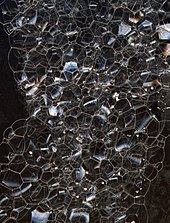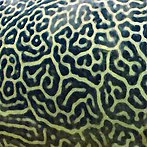Pattern
A pattern is a regularity in the world, in human-made design, design.
Any of the
: 6 indeed, mathematics can be seen as the search for regularities, and the output of any function is a mathematical pattern. Similarly in the sciences, theories explain and predict regularities in the world.In many areas of the decorative arts, from ceramics and textiles to wallpaper, "pattern" is used for an ornamental design that is manufactured, perhaps for many different shapes of object. In art and architecture, decorations or visual motifs may be combined and repeated to form patterns designed to have a chosen effect on the viewer.
Nature
Nature provides examples of many kinds of pattern, including
Symmetry
Symmetry is widespread in living things. Animals that move usually have bilateral or
Among non-living things,
Spirals

Spiral patterns are found in the body plans of animals including
Chaos, turbulence, meanders and complexity
Waves, dunes


Waves are disturbances that carry energy as they move. Mechanical waves propagate through a medium – air or water, making it oscillate as they pass by.[10] Wind waves are surface waves that create the chaotic patterns of the sea. As they pass over sand, such waves create patterns of ripples; similarly, as the wind passes over sand, it creates patterns of dunes.[11]
Bubbles, foam

Cracks

Cracks form in materials to relieve stress: with 120 degree joints in elastic materials, but at 90 degrees in inelastic materials. Thus the pattern of cracks indicates whether the material is elastic or not. Cracking patterns are widespread in nature, for example in rocks, mud, tree bark and the glazes of old paintings and ceramics.[14]
Spots, stripes
Art and architecture
Tilings
In visual art, pattern consists in regularity which in some way "organizes surfaces or structures in a consistent, regular manner." At its simplest, a pattern in art may be a geometric or other repeating shape in a painting, drawing, tapestry, ceramic tiling or carpet, but a pattern need not necessarily repeat exactly as long as it provides some form or organizing "skeleton" in the artwork.[18] In mathematics, a tessellation is the tiling of a plane using one or more geometric shapes (which mathematicians call tiles), with no overlaps and no gaps.[19]
Zentangle
The materials and teaching tools of Zentangle® (a blend of meditative Zen practice with the purposeful drawing of repetitive patterns or artistic tangles) has been copyrighted by Rick Roberts and Maria Thomas.[20] The process, using patterns such as cross hatching, dots, curves and other mark making, on small pieces of paper or tiles which can then be put together to form mosaic clusters, or shaded or coloured in, can, like the doodle, be used as a therapeutic device to help to relieve stress, anxiety and depressive symptoms in children, adults and older adults.[21] [22][23]
In architecture

In architecture, motifs are repeated in various ways to form patterns. Most simply, structures such as windows can be repeated horizontally and vertically (see leading picture). Architects can use and repeat decorative and structural elements such as columns, pediments, and lintels.[24] Repetitions need not be identical; for example, temples in South India have a roughly pyramidal form, where elements of the pattern repeat in a fractal-like way at different sizes.[25]

See also:
Science and mathematics
Mathematics is sometimes called the "Science of Pattern", in the sense of rules that can be applied wherever needed.[26] For example, any sequence of numbers that may be modeled by a mathematical function can be considered a pattern. Mathematics can be taught as a collection of patterns.[27]
Real patterns
Daniel Dennett's notion of real patterns, discussed in his 1991 paper of the same name,[28] provides an ontological framework aiming to discern the reality of patterns beyond mere human interpretation, by examining their predictive utility and the efficiency they provide in compressing information. For example, centre of gravity is a real pattern because it allows us to predict the movements of a bodies such as the earth around the sun, and it compresses all the information about all the particles in the sun and the earth that allows us to make those predictions.
Fractals
Some mathematical rule-patterns can be visualised, and among these are those that explain
In pattern theory, devised by Ulf Grenander, mathematicians attempt to describe the world in terms of patterns. The goal is to lay out the world in a more computationally friendly manner.[30]
In the broadest sense, any regularity that can be explained by a scientific theory is a pattern. As in mathematics, science can be taught as a set of patterns.[31]
A recent study from Aesthetics and Psychological Effects of Fractal Based Design[32] suggested that fractal patterns possess self-similar components that repeat at varying size scales. The perceptual experience of human-made environments can be impacted with inclusion of these natural patterns. Previous work has demonstrated consistent trends in preference for and complexity estimates of fractal patterns. However, limited information has been gathered on the impact of other visual judgments. Here we examine the aesthetic and perceptual experience of fractal ‘global-forest’ designs already installed in humanmade spaces and demonstrate how fractal pattern components are associated with positive psychological experiences that can be utilized to promote occupant wellbeing. These designs are composite fractal patterns consisting of individual fractal ‘tree-seeds’ which combine to create a ‘global fractal forest.’ The local ‘tree-seed’ patterns, global configuration of tree-seed locations, and overall resulting ‘global-forest’ patterns have fractal qualities. These designs span multiple mediums yet are all intended to lower occupant stress without detracting from the function and overall design of the space. In this series of studies, we first establish divergent relationships between various visual attributes, with pattern complexity, preference, and engagement ratings increasing with fractal complexity compared to ratings of refreshment and relaxation which stay the same or decrease with complexity. Subsequently, we determine that the local constituent fractal (‘tree-seed’) patterns contribute to the perception of the overall fractal design, and address how to balance aesthetic and psychological effects (such as individual experiences of perceived engagement and relaxation) in fractal design installations. This set of studies demonstrates that fractal preference is driven by a balance between increased arousal (desire for engagement and complexity) and decreased tension (desire for relaxation or refreshment). Installations of these composite mid-high complexity ‘global-forest’ patterns consisting of ‘tree-seed’ components balance these contrasting needs, and can serve as a practical implementation of biophilic patterns in human-made environments to promote occupant wellbeing.
See also
- Archetype
- Cellular automata
- Die (manufacturing) (template)
- Form constant
- Fractal
- Pattern (casting)
- Pattern coin
- Pattern matching
- Pattern (sewing)
- Pattern recognition
- Patterns in nature
- Pedagogical patterns
- Software design pattern
- Template method pattern
References
- ^ Garai, Achraf (3 March 2022). "What are design patterns?". achrafgarai.com. Retrieved 1 January 2023.
- ^ OCLC 50272461.
- ^ Stevens, Peter. Patterns in Nature, 1974. Page 3.
- ^ Kappraff, Jay (2004). "Growth in Plants: A Study in Number" (PDF). Forma. 19: 335–354. Archived from the original (PDF) on 2016-03-04. Retrieved 2013-01-18.
- .
- S2CID 34610459.
- ISBN 978-0486434858.
- ^ Lewalle, Jacques (2006). "Flow Separation and Secondary Flow: Section 9.1" (PDF). Lecture Notes in Incompressible Fluid Dynamics: Phenomenology, Concepts and Analytical Tools. Syracuse, NY: Syracuse University. Archived from the original (PDF) on 2011-09-29.
- .
- ^ French, A.P. Vibrations and Waves. Nelson Thornes, 1971.[full citation needed]
- ^ Tolman, H.L. (2008). "Practical wind wave modeling" (PDF). In Mahmood, M.F. (ed.). CBMS Conference Proceedings on Water Waves: Theory and Experiment. Howard University, USA, 13–18 May 2008. World Scientific Publ.
- ^ Ball, Philip. Shapes, 2009. pp. 68, 96-101.[full citation needed]
- Jean E. Taylor, The geometry of soap films and soap bubbles, Scientific American, vol. 235, pp. 82–93, July 1976.
- ^ Stevens, Peter. 1974. Page 207.
- S2CID 937133.
- ISBN 978-3-662-08539-4.
- ^ Ball, Philip. Shapes, 2009. pp. 159–167.[full citation needed]
- ^ Jirousek, Charlotte (1995). "Art, Design, and Visual Thinking". Pattern. Cornell University. Retrieved 12 December 2012.
- ISBN 9780716711933.
- ^ "Zentangle". Zentangle. Retrieved 2023-02-03.
- S2CID 236092775.
- S2CID 251444115.
- PMID 37359601.
- ^ Adams, Laurie (2001). A History of Western Art. McGraw Hill. p. 99.
- ^ Jackson, William Joseph (2004). Heaven's Fractal Net: Retrieving Lost Visions in the Humanities. Indiana University Press. p. 2.
- JSTOR 2214851.
- ^ Bayne, Richard E (2012). "MATH 012 Patterns in Mathematics - spring 2012". Archived from the original on 7 February 2013. Retrieved 16 January 2013.
- ^ Dennett, D. C. (1991). Real Patterns. The Journal of Philosophy, 88(1), 27-51.
- ISBN 978-0-7167-1186-5.
- ^ Grenander, Ulf; Miller, Michael (2007). Pattern Theory: From Representation to Inference. Oxford University Press.
- ^ "Causal Patterns in Science". Harvard Graduate School of Education. 2008. Retrieved 16 January 2013.
- PMID 34484047.
Bibliography
In nature
- Adam, John A. Mathematics in Nature: Modeling Patterns in the Natural World. Princeton, 2006.
- Ball, Philip The Self-made Tapestry: Pattern Formation in Nature. Oxford, 2001.
- Edmaier, Bernhard Patterns of the Earth. Phaidon Press, 2007.
- Art Forms of Nature. Dover, 1974.
- Stevens, Peter S. Patterns in Nature. Penguin, 1974.
- Stewart, Ian. What Shape is a Snowflake? Magical Numbers in Nature. Weidenfeld & Nicolson, 2001.
- ISBN 0-486-67135-6
In art and architecture
- Alexander, C. A Pattern Language: Towns, Buildings, Construction. Oxford, 1977.
- de Baeck, P. Patterns. Booqs, 2009.
- Garcia, M. The Patterns of Architecture. Wiley, 2009.
- Kiely, O. Pattern. Conran Octopus, 2010.
- Pritchard, S. V&A Pattern: The Fifties. V&A Publishing, 2009.
In science and mathematics
- Adam, J. A. Mathematics in Nature: Modeling Patterns in the Natural World. Princeton, 2006.
- Resnik, M. D. Mathematics as a Science of Patterns. Oxford, 1999.
In computing
- Gamma, E., Helm, R., Johnson, R., Vlissides, J. Design Patterns. Addison-Wesley, 1994.
- Bishop, C. M. Pattern Recognition and Machine Learning. Springer, 2007.









